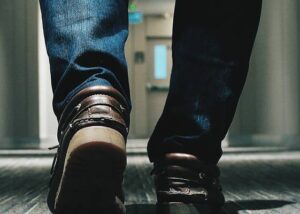Did Abu Bakr (May Allah Most High be pleased with him) allow his lower garment to drag on the ground?
Quran
Hadith
Islamic Text
Yes, Sayidina Abu Bakr (May Allah Most High be pleased with him) did allow his lower garment to drag on the ground. However, this was not premeditated. Rather it was due to a lack of strict observance.
عَنْ عَبْدِ اللَّهِ بْنِ عُمَرَ رَضِيَ اللَّهُ عَنْهُمَا، قَالَ: قَالَ رَسُولُ اللَّهِ صَلَّى اللهُ عَلَيْهِ وَسَلَّمَ: «مَنْ جَرَّ ثَوْبَهُ خُيَلاَءَ، لَمْ يَنْظُرِ اللَّهُ إِلَيْهِ يَوْمَ القِيَامَةِ» فَقَالَ أَبُو بَكْرٍ: إِنَّ أَحَدَ شِقَّيْ ثَوْبِي يَسْتَرْخِي، إِلَّا أَنْ أَتَعَاهَدَ ذَلِكَ مِنْهُ؟ فَقَالَ رَسُولُ اللَّهِ صَلَّى اللهُ عَلَيْهِ وَسَلَّمَ: «إِنَّكَ لَسْتَ تَصْنَعُ ذَلِكَ خُيَلاَءَ
Abdullah bin Umar (May Allah Most High be pleased with them both) said, that Allah’s Messenger ﷺ said, ‘On the Day of Judgment, Allah (Most High) will not look at a person who drags his robe (behind him) out of arrogance.’ Abu Bakr (May Allah Most High be pleased with him) said, ‘One side of my garment slides down if I do not pay attention to it.’ So Allah’s Messenger ﷺ said, ‘You do not do that out of arrogance.’ (Sahih al-Bukhari, 3665).
In the Hadith above we find Sayidina Abu Bakr (May Allah Most High be pleased with him) expressing great concern when the Prophet ﷺ spoke against garments dragging on the ground. However, the Holy Prophet ﷺ clarified for Sayidina Abu Bakr (May Allah Most High be pleased with him) that it is not a concern unless it is done in arrogance. The Hadith also conveys the virtue of Sayidina Abu Bakr (May Allah Most High be pleased with him), since the Holy Prophet ﷺ confirmed an absence of arrogance for him, which is an immense blessing.
(إِنَّك لست تصنع ذَلِك خُيَلَاء) وَفِيه: فَضِيلَة لأي بكر حَيْثُ شهد النَّبِي صلى الله عَلَيْهِ وَسلم، لَهُ بِمَا يُنَافِي مَا يكره. (عمدة القاري شرح صحيح البخاري)
‘You do not do that out of arrogance.’ This contains (a mention of) the virtue of (Sayidina) Abu Bakr, since the Prophet ﷺ testified for him in a manner that negates that which is disapproved of (arrogance). (Imam Badr al-Deen al-Ayni, Umdatu al-Qari Sharh Sahih al-Bukhari).
The Hadith also serves as persuasive evidence for scholars who say that the prohibition on dragging garments is only applicable if one does it out of arrogance. Otherwise, there is no prohibition. However, the Sunnah is to restrict the garments to mid-shin.
التَّقْيِيدُ بِالْخُيَلَاءِ يَخْرُجُ مَا إذَا جَرَّهُ بِغَيْرِ هَذَا الْقَصْدِ، وَيَقْتَضِي أَنَّهُ لَا تَحْرِيمَ فِيهِ وَقَدْ تَقَدَّمَ مِنْ صَحِيحِ الْبُخَارِيِّ وَغَيْرِهِ قَوْلُ أَبِي بَكْرٍ – رَضِيَ اللَّهُ عَنْهُ -: إنَّ أَحَدَ شِقَّيْ ثَوْبِي يُسْتَرْخَى إلَّا أَنْ أَتَعَاهَدَ ذَلِكَ مِنْهُ فَقَالَ رَسُولُ اللَّهِ – صَلَّى اللَّهُ عَلَيْهِ وَسَلَّمَ – إنَّك لَسْت تَصْنَعُ ذَلِكَ خُيَلَاءَ
وَبَوَّبَ الْبُخَارِيُّ فِي صَحِيحِهِ بَابَ مَنْ جَرَّ إزَارَهُ مِنْ غَيْرِ خُيَلَاءَ، وَأَوْرَدَ فِيهِ هَذَا الْحَدِيثَ وَحَدِيثَ أَبِي بَكْرَةَ «خَسَفَتْ الشَّمْسُ وَنَحْنُ عِنْدَ النَّبِيِّ – صَلَّى اللَّهُ عَلَيْهِ وَسَلَّمَ – فَقَامَ يَجُرُّ ثَوْبَهُ مُسْتَعْجِلًا حَتَّى أَتَى الْمَسْجِدَ» الْحَدِيثَ، وَقَالَ النَّوَوِيُّ فِي شَرْحِ مُسْلِمٍ ظَوَاهِرُ الْأَحَادِيثِ فِي تَقْيِيدِهَا بِالْجَرِّ خُيَلَاءَ يَدُلُّ عَلَى أَنَّ التَّحْرِيمَ مَخْصُوصٌ بِالْخُيَلَاءِ وَكَذَا نَصَّ الشَّافِعِيُّ عَلَى الْفَرْقِ كَمَا ذَكَرْنَا
وَأَمَّا الْقَدْرُ الْمُسْتَحَبُّ فِيمَا يُتْرَكُ إلَيْهِ طَرْفُ الْقَمِيصِ أَوْ الْإِزَارِ فَنِصْفُ السَّاقَيْنِ. (طرح التثريب في شرح التقريب)
It is restricted to arrogance. It (prohibition) is not applicable if one drags the garments without this intention (of arrogance). Therefore, it dictates no prohibition without it (arrogance). Indeed, the statement of Abu Bakr has already been narrated from Sahih al-Bukhari and others: ‘One side of my garment slides down if I do not pay attention to it.’ So Allah’s Messenger ﷺ said, ‘You do not do that out of arrogance.’
(Imam) al-Bukhari named a chapter in his Sahih, ‘The one who drags his garment without arrogance.’ And he narrated this Hadith in it, and the Hadith of Abu Bakrah: ‘The Sun eclipsed whilst we were with the Prophet ﷺ. He ﷺ stood up dragging his garment until he ﷺ reached the Masjid.’ (Imam) al-Nawawi said in Sharh Muslim, ‘The wording of the Hadith narrations supports restriction (of the prohibition) to (the intention of) arrogance. They (the Hadith narrations) prove that the prohibition is specified to arrogance. As mentioned by (Imam) al-Shafi, differentiating in the way we have mentioned.’
As for the recommended length of the long-shirt or Izaar (loincloth), it is to mid-shin. (Imam Abu al-Fadl Zayn al-Deen al-Iraqi, Tarh al-Taqreeb Fi Sharh al-Taqreeb).
In the Nass (text) above Imam al-Iraqi is very clear on the issue of prohibition being depended upon intending arrogance. Therefore, if one does not intend arrogance when allowing one’s garments to extend beyond the ankles, then it is not prohibited. However, Imam al-Iraqi does clarify that the recommendation for men is to wear garments to mid-shin.
(فقال: إنك لست تصنع خيلاء) دل على أن مناط الذم هو الخيلاء. (الكوثر الجاري إلى رياض أحاديث البخاري)
You do not do that out of arrogance. This (Hadith) proves that the legal basis for blame (in allowing the garments to extend beyond the ankles) is arrogance. (Imam al-Koorani, al-Kowthar al-Jari).
Due to the clear evidence in the Hadith above we can say that Sayidina Abu Bakr (May Allah Most High be pleased with him) did allow his lower garment to drag on the ground. But this was due to a lack of concern, not out of arrogance. The fact that the Holy Prophet ﷺ did not rebuke him for it and did not insist upon him paying more attention to it, demonstrates to us that it is not absolutely prohibited to allow one’s garment to drag on the ground. Had there been an absolute prohibition, the Holy Prophet ﷺ would have been insistent upon Sayidina Abu Bakr paying more attention to it.
Unfortunately there are some people in our communities that insist that it is absolutely prohibited for a man to allow his garments to extend beyond his ankles, irrespective of intending arrogance or not. Many of them do not consider the opinions of leading Imams of Ahl Sunnah, and present the issue as black and white without any room to differ with them. In doing so, they not only undermine strongly evidenced views of major scholars but they also ignore numerous authentic Hadith narrations.
And Allah Most High Knows Best.
-Answered by Shaykh Noorud-deen Rashid (22.01.2022)
See also:
Is it Sunnah to wear trousers to the middle of the shin?
Is it Haram to allow trousers to extend beyond the ankles?
Hadith in which the Prophet allowed his garment to drag below the ankles
Reconciling the Hadith about wearing trousers beyond the ankles
See also (video):






